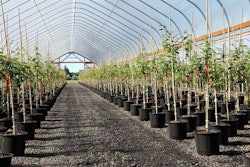 A canker on an eastern black walnut tree. The beetle that carries the fungus is only one-sixteenth of an inch long. Photo: Colorado State University photo/Ned Tisserat
A canker on an eastern black walnut tree. The beetle that carries the fungus is only one-sixteenth of an inch long. Photo: Colorado State University photo/Ned TisseratThe black walnut trees of New York are at risk of falling to thousand cankers disease (TCD) as it has spread to Pennsylvania.
This disease originated in New Mexico and spread through Western states such as California and Arizona. In 2010, it reached Tennessee. Since then, it has spread to North Carolina, Virginia, Maryland, Indiana, Ohio and Pennsylvania.
“It could come into New York at any time,” Karen Snover-Clift, director of the plant disease diagnostic clinic at Cornell University, told Syracuse.com. “If it can survive in Pennsylvania, I’m sure it can survive in areas of New York.”
TCD is spread by the walnut twig beetle when it bores into a walnut tree. The spores of the fungus Geosmithia morbida are present on the beetle; consequently, every time the insect tunnels into a tree, a canker is created under the bark.
Because these diseased areas are hidden underneath the bark, an infestation is likely to go unnoticed for some time. It can take a number of years before enough cankers have formed to kill the tree.
When the leaves on the exterior crown begin to yellow, the tree is in its final stages and generally dies three years after these symptoms are noted.
New York has been monitoring the situation closely and neither the fungus nor the beetle has been sighted, according to Lori Severino, spokeswoman for the state Department of Environmental Conservation.
“We are very concerned about the arrival and rapid detection of this potentially serious pest of our walnut and butternut trees,” she said.
So far there are six infected counties adjacent to New York. Logan D. Hall, spokesman for the Pennsylvania Department of Agriculture, reported no new infestations from last year. The 2016 survey is under way now.
According to the New York Invasive Species Information website, the state’s black walnut timberland is valued at more than $500 billion.
“We do have a significant amount, and it would be a big issue for producers of black walnut lumber and even black walnut syrup,” said Cornell’s Snover-Clift.
The disease has no cure and its potential effect has been likened to the American chestnut blight and Dutch elm disease.
“The impact of (thousand cankers) on black walnut in its native range is unclear; however, scientists speculate that, if left unmanaged, this disease could cause the extinction of this important native timber/nut/nursery crop/mast producer in the eastern U.S.,” a 2011 study in the journal Forests reported.
Currently 18 states have a quarantine in effect to prevent the spread of TCD. The beetles can survive in bark mulch and other remains of an infected tree.









